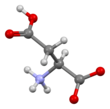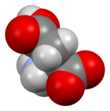Aspartic acid
 Skeletal formula of L-aspartic acid
| |||
| |||
| Names | |||
|---|---|---|---|
IUPAC name
| |||
Other names
| |||
| Identifiers | |||
3D model (
JSmol ) |
| ||
| ChEBI |
| ||
| ChEMBL |
| ||
| ChemSpider | |||
| DrugBank |
| ||
ECHA InfoCard
|
100.000.265 | ||
| EC Number |
| ||
| KEGG |
| ||
PubChem CID
|
|||
| UNII |
| ||
CompTox Dashboard (EPA)
|
|||
| |||
| |||
| Properties | |||
| C4H7NO4 | |||
| Molar mass | 133.103 g·mol−1 | ||
| Appearance | colourless crystals | ||
| Density | 1.7 g/cm3 | ||
| Melting point | 270 °C (518 °F; 543 K) | ||
| Boiling point | 324 °C (615 °F; 597 K) (decomposes) | ||
| 4.5 g/L[2] | |||
| Acidity (pKa) |
| ||
Conjugate base
|
Aspartate | ||
| -64.2·10−6 cm3/mol | |||
| Hazards | |||
| NFPA 704 (fire diamond) | |||
| Supplementary data page | |||
| Aspartic acid (data page) | |||
Except where otherwise noted, data are given for materials in their standard state (at 25 °C [77 °F], 100 kPa).
| |||
Aspartic acid (symbol Asp or D;[4] the ionic form is known as aspartate), is an α-amino acid that is used in the biosynthesis of proteins.[5] The L-isomer of aspartic acid is one of the 22 proteinogenic amino acids, i.e., the building blocks of proteins.
D-aspartic acid is one of two D-amino acids commonly found in mammals.
Like all other amino acids, aspartic acid contains an amino group and a carboxylic acid. Its α-amino group is in the protonated –NH+
3 form under physiological conditions, while its α-carboxylic acid group is deprotonated −COO− under physiological conditions. Aspartic acid has an acidic side chain (CH2COOH) which reacts with other amino acids, enzymes and proteins in the body.
In proteins aspartate sidechains are often hydrogen bonded to form
Aspartic acid, like
The one-letter code D for aspartate was assigned arbitrarily,[8] with the proposed memnonic asparDic acid.[9]
Discovery
Aspartic acid was first discovered in 1827 by Auguste-Arthur Plisson and Étienne Ossian Henry[10][11] by hydrolysis of asparagine, which had been isolated from asparagus juice in 1806.[12] Their original method used lead hydroxide, but various other acids or bases are now more commonly used instead.[citation needed]
Forms and nomenclature
There are two forms or enantiomers of aspartic acid. The name "aspartic acid" can refer to either enantiomer or a mixture of two.[13] Of these two forms, only one, "L-aspartic acid", is directly incorporated into proteins. The biological roles of its counterpart, "D-aspartic acid" are more limited. Where enzymatic synthesis will produce one or the other, most chemical syntheses will produce both forms, "DL-aspartic acid", known as a racemic mixture.[citation needed]
Synthesis
Biosynthesis
In the human body, aspartate is most frequently synthesized through the
Chemical synthesis
Industrially, aspartate is produced by amination of
Metabolism
In plants and microorganisms, aspartate is the precursor to several amino acids, including four that are essential for humans: methionine, threonine, isoleucine, and lysine. The conversion of aspartate to these other amino acids begins with reduction of aspartate to its "semialdehyde", O2CCH(NH2)CH2CHO.[16] Asparagine is derived from aspartate via transamidation:
- −O2CCH(NH2)CH2CO2− + GC(O)NH3+ → O2CCH(NH2)CH2CONH3+ + GC(O)O
(where GC(O)NH2 and GC(O)OH are glutamine and glutamic acid, respectively)
Other biochemical roles
Aspartate has many other biochemical roles. It is a
Interactive pathway map
Click on genes, proteins and metabolites below to link to respective articles.[§ 1]
- ^ The interactive pathway map can be edited at WikiPathways: "GlycolysisGluconeogenesis_WP534".
Neurotransmitter
Aspartate (the
Applications & market
In 2014, the global market for aspartic acid was 39.3 thousand short tons (35.7 thousand tonnes)[20] or about $117 million annually[21] with potential areas of growth accounting for an addressable market[clarification needed] of $8.78 billion (Bn).[22] The three largest market segments include the U.S., Western Europe, and China. Current applications include biodegradable polymers (polyaspartic acid), low calorie sweeteners (aspartame), scale and corrosion inhibitors, and resins.[citation needed]
Superabsorbent polymers
One area of aspartic acid market growth is
Additional uses
In addition to SAP, aspartic acid has applications in the $19Bn fertilizer industry, where polyaspartate improves water retention and nitrogen uptake;[26] the $1.1Bn (2020) concrete floor coatings market, where polyaspartic is a low VOC, low energy alternative to traditional epoxy resins;[27] and lastly the >$5Bn scale and corrosion inhibitors market.[28]
Sources
This section needs additional citations for verification. (January 2021) |
Dietary sources
Aspartic acid is not an essential amino acid, which means that it can be synthesized from central metabolic pathway intermediates in humans, and does not need to be present in the diet. In eukaryotic cells, roughly 1 in 20 amino acids incorporated into a protein is an aspartic acid,[29] and accordingly almost any source of dietary protein will include aspartic acid. Additionally, aspartic acid is found in:
- Dietary supplements, either as aspartic acid itself or salts (such as magnesium aspartate)
- The sweetener aspartame, which is made from an aspartic acid and phenylalanine
See also
- Aspartate transaminase
- Polyaspartic acid
- Sodium polyaspartate, a synthetic polyamide
References
- ISBN 978-0-911910-28-5.
- ^ "ICSC 1439 - L-ASPARTIC ACID". inchem.org.
- ISBN 978-1498754286.
- ^ "Nomenclature and Symbolism for Amino Acids and Peptides". IUPAC-IUB Joint Commission on Biochemical Nomenclature. 1983. Archived from the original on 9 October 2008. Retrieved 5 March 2018.
- ^ )
- ^ S2CID 12709991.
- PMID 16525061.
- .
- .
- ^ Plisson, A. (October 1827). "Sur l'identité du malate acide d'althéine avec l'asparagine (1); et sur un acide nouveau" [On the identity of altheine acid malate with asparagine (1); and on a new acid]. Journal de Pharmacie (in French). 13 (10): 477–492.
- ^ Berzelius JJ, Öngren OG (1839). Traité de chimie (in French). Vol. 3. Brussels: A. Wahlen et Cie. p. 81. Retrieved 25 August 2015.
- ^ Plimmer R (1912) [1908]. Plimmer R, Hopkins F (eds.). The chemical composition of the proteins. Monographs on Biochemistry. Vol. Part I. Analysis (2nd ed.). London: Longmans, Green and Co. p. 112. Retrieved January 18, 2010.
- .
- ISBN 978-3527306732.)
{{cite encyclopedia}}: CS1 maint: multiple names: authors list (link - ^ Dunn MS, Smart BW (1950). "DL-Aspartic Acid". Organic Syntheses. 30: 7; Collected Volumes, vol. 4, p. 55..
- ISBN 1-57259-153-6.
- ^ "Biochemistry - Biochemistry". www.varsitytutors.com. Retrieved 2022-02-18.
- PMID 11568288.)
{{cite journal}}: CS1 maint: multiple names: authors list (link - S2CID 13505187.
- ^ "Global Aspartic Acid Market By Application". Grand View Research. Retrieved November 30, 2019.
- ^ Evans J (2014). Commercial Amino Acids. BCC Research. pp. 101–103.
- ^ a b Transparency Market Research. Superabsorbent polymers market - global industry analysis, size, share, growth, trends and forecase, 2014-2020. (2014).
- ^ PMID 31799235.
- S2CID 232761877.
- .
- ^ Kelling K (2001). Crop Responses to Amisorb in the North Central Region. University of Wisconsin-Madison.
- ^ Global concrete floor coatings market will be worth US$1.1Bn by 2020. Transparency Market Research (2015).
- ^ Corrosion inhibitors market analysis by product, by application, by end-use industry, and segment forecasts to 2020. Grand View Research (2014)
- PMID 27789699.
External links
- GMD MS Spectrum
- American Chemical Society (21 April 2010). "Ancestral Eve' Crystal May Explain Origin of Life's Left-Handedness". ScienceDaily. Archived from the original on 23 April 2010. Retrieved 2010-04-21.





